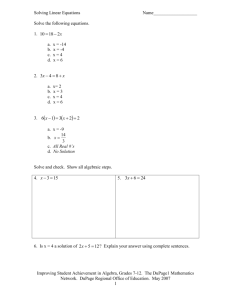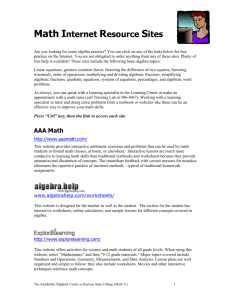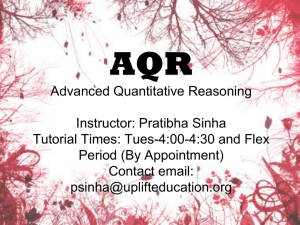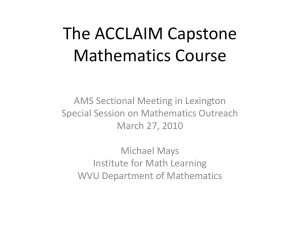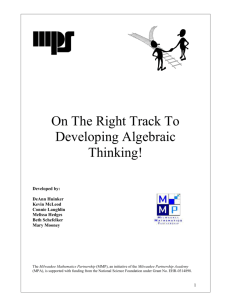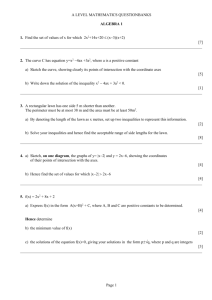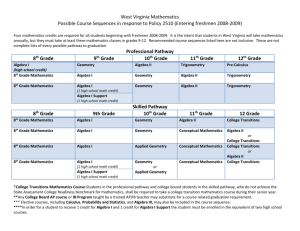Improving Pass Rates in Mathematics using
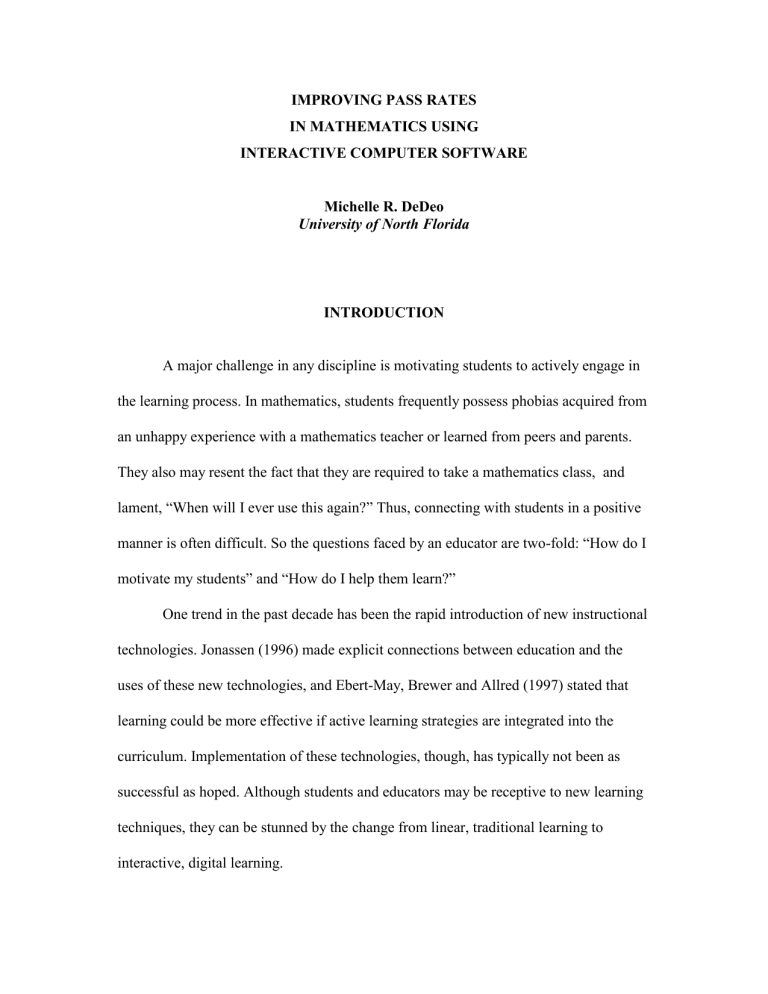
IMPROVING PASS RATES
IN MATHEMATICS USING
INTERACTIVE COMPUTER SOFTWARE
Michelle R. DeDeo
University of North Florida
INTRODUCTION
A major challenge in any discipline is motivating students to actively engage in the learning process. In mathematics, students frequently possess phobias acquired from an unhappy experience with a mathematics teacher or learned from peers and parents.
They also may resent the fact that they are required to take a mathematics class, and lament, “When will I ever use this again?” Thus, connecting with students in a positive manner is often difficult. So the questions faced by an educator are two-fold: “How do I motivate my students” and “How do I help them learn?”
One trend in the past decade has been the rapid introduction of new instructional technologies. Jonassen (1996) made explicit connections between education and the uses of these new technologies, and Ebert-May, Brewer and Allred (1997) stated that learning could be more effective if active learning strategies are integrated into the curriculum. Implementation of these technologies, though, has typically not been as successful as hoped. Although students and educators may be receptive to new learning techniques, they can be stunned by the change from linear, traditional learning to interactive, digital learning.
A method of easing this transition is to implement technology in the classroom as an aid to the teaching process rather than as a replacement. In this way, students are eased into the technological environment and thus feel more comfortable learning in it.
Also, the use of software that is individually paced and that can be used by the student at times convenient to them alleviates the embarrassment that students often face when asking questions in a large lecture, and gives the student flexibility in the learning process. So the issue becomes to determine which type of technology is able to accomplish this feat and to decide on its use.
There are a number of programs from which educators can choose, and implementing a system is not a task to be taken lightly. At the University of North
Florida (UNF) in Jacksonville, more than 1000 students enroll each year in college algebra to fulfill graduation requirements. The success rates in the traditional college algebra classes (grades of A, B, or C) over a period of years had hovered around 50%, which is unacceptably low. It was determined by the mathematics faculty that technology that could be used to address this situation was available from Academic
Systems
.
Factors that influenced this decision were the success rate of the Academic
Systems program at other institutions, the ability to tailor the software to meet the instructional needs of the faculty, and its ease of use.
2
IMPLEMENTATION
After 3 years in the planning stage and nearly $100,000 dollars in the creation of a 40-seat college algebra lab and other expenses, 16 sections utilizing Academic
Systems
Interactive Mathematics were held in the 1999-2000 academic year. In the
Fall 2000 term, 14 more sections of college algebra were implemented using this system. In addition to the traditional three hours per week of class time (two in lecture and one in recitation), an additional no-credit lab hour was scheduled for the students.
These required laboratory sessions were monitored by teaching assistants (T.A.’s).
The software is supported by Academic Systems’ basic text materials, and can be tailored for classes ranging from introductory intermediate algebra to college algebra.
Content flexibility and comprehensive coverage, as well as an instructional support system that tracks and reports student progress, are crucial in the methods’ overall success and the resulting success of the students.
EFFECTIVENESS
Student performance in 16 sections of College Algebra that used the software
(Pilot Group) was compared with that of students in 13 sections that were taught in the traditional method (Control Group) during the 1999-2000 academic year. In the first weeks, the Pilot Group spent time learning the technology and the system as well as trying to learn the mathematics content. This resulted in significant frustration as the students overcame the initial learning curve associated with using new software and
3
with system delays due to server problems. However, extra time in the lab fostered a camaraderie between students and confidence to keep going. By the end of the third week, most Pilot Group students had a firm grasp of the system’s layout, its flaws and its nuances.
Two factors of success were measured in the college algebra classes: pass rate and retention rate. (At UNF, a withdrawal is considered a fail in terms of reporting success of the student). As evidenced by the pass and retention rates in Table 1, the overall success of the Pilot Group was significantly higher than the Control Group.
Pass
Withdraw
Fail
Table 1: Comparison of Success between the Pilot Group and Control Group
Percentage Change
Ratio: Pass/No Pass
Pilot Group
N=978
69%
15%
16%
4.3 to1
Control Group
N=1049
57%
21%
22%
2.6 to1
21%
-28%
-27%
1.7 to 1
There are many facets of the software that seem to contribute to this success.
First, the program integrates video, audio and interactive graphics to take the student through each problem in a step-by-step manner and presents the material in several different ways. This asynchronous learning environment slows the dynamic interaction and provides opportunity for reflection (Nulden and Hardless, 1999). The student’s ability to see and hear also encourages them to become active learners. Students also benefit from the ability to choose activities they find helpful and to check their understanding with real-time feedback, something that is rare in the traditional classroom setting. In addition, they are given an almost unlimited amount of practice.
4
Since there is a goal at the end of each module (i.e. a quiz to be taken), students in the Pilot Group were compelled to complete each module within a designated time frame. This is in contrast to some students in the Control Group who would fall behind and stay behind throughout the semester.
CONCLUSIONS
The results of the quantitative data indicate that the mediated learning approach is successful in increasing pass rates in mathematics and may indeed offer at-risk students a better chance to pass. It must be noted that the successes are not dependent on the technology itself, but in the ability to incorporate it into the learning environment.
The program is also economically worthwhile. These economic benefits include cost savings (students receive course materials and access to the software system at a price slightly lower than the cost of a standard algebra text), revenue generation (the cost of the course includes a few extra dollars to cover some of the cost of laboratory assistants during open lab hours), and non-cash economic value. The initial costs are well worth the investment. Besides reducing the financial and mental costs students incur when repeating a course, the state benefits in not having to pay for a repeated course, the possible extra semester that a student may have to be enrolled, and the possible lost investment of a student who drops out (Mediated Learning, 1999).
The next phase in the process is to experiment with eliminating the required lab hour, and to give the students the software to use at home. If successful, this will eliminate the cost of a T.A. for each mandatory lab hour per week and at the same time give the students the opportunity to work from home at any hour convenient to them. A
5
foreseeable downside to this change would be a possible decrease in motivation resulting from losing part of the structure of the course. There are four sections in Fall
2000 and eight sections in Spring 2001 classes of this type. It is hoped that these classes will be as successful as the current ones.
REFERENCES
Ebert-May, D., Brewer, C. and Allred, S. (1997) Innovation in large lectures--teaching for active learning. Bioscience, 47, 601-607.
Interactive Mathematics (1999) The Economics of Mediated Learning [On-line].
Available:http://204.176.10.99/Interactive_Mathematics/Library/Mediated_Learning/Eco nomics_Of_Mediated_Learning.asp
Jonassen, D. H. (1996) Computers in the Classroom: Mindtools for critical thinking.
Englewood Cliffs, NJ: Merrill/Prentice-Hall.
Nulden, U. & Hardless, C. (1999). Activity Visualization and Formative Assessment in
Virtual Learning Environments. In J.A. Chambers (Ed.), Selected Papers from the 10th
National Conference on College Teaching and Learning (pp. 117-125). Jacksonville,
FL: Florida Community College at Jacksonville .
6



